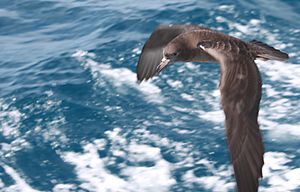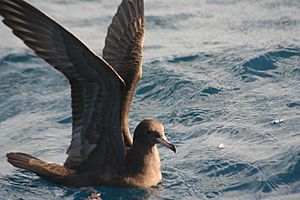Flesh-footed Shearwater facts for kids
Quick facts for kids Flesh-footed Shearwater |
|
|---|---|
 |
|
| Conservation status | |
| Scientific classification | |
| Kingdom: | |
| Phylum: | |
| Class: | |
| Order: | |
| Family: | |
| Genus: |
Ardenna
|
| Species: |
A. carneipes
|
| Binomial name | |
| Ardenna carneipes (Gould, 1844)
|
|
The flesh-footed shearwater (Ardenna carneipes) is a medium-sized seabird known for its long, narrow wings. It used to be called Puffinus carneipes. This bird has black feathers all over its body. It has pale pink feet and a light-colored beak with a clear black tip. It belongs to a group of large shearwaters now placed in the Ardenna genus.
Contents
Where Do They Live?
Flesh-footed shearwaters live in colonies, which are large groups of birds. They have two main areas where they breed and raise their young.
Pacific Ocean Breeding Areas
One main breeding area is in the southwest Pacific Ocean. Here, you can find them on:
- Lord Howe Island, with about 16,900 pairs.
- South Australia, with around 1,800 pairs on two islands.
- Northern New Zealand, home to about 13,000 pairs.
Western Australia and Indian Ocean
The other large group lives along the coast of Western Australia. Up to 36,000 pairs breed on 42 islands, from Cape Leeuwin to the Recherche Archipelago. About 500 pairs also breed on St Paul Island in the Indian Ocean.
There have been reports of these birds near Astola Island in Pakistan, in the Arabian Sea.
Why Are They in Danger?
Sadly, the number of flesh-footed shearwaters is going down in many places. Because of this, they are now listed as 'Near Threatened' in Australia. In New Zealand, they are 'Nationally Vulnerable'. This means they need special protection.
Threats from Fishing
These birds spend a lot of time in the North Pacific Ocean during the summer. Here, many shearwaters are accidentally caught by fishing boats. This is called "bycatch" and it is a big problem for them.
Pollution and Climate Change
Flesh-footed shearwaters also face other dangers:
- Climate change: Changes in the climate can affect their food sources and habitats.
- Pollution: They can get sick from heavy metals in the ocean. Scientists think this might happen when the birds eat a lot of plastic. The birds mistake plastic floating on the ocean surface for food.
Protecting These Birds
Because they are in danger, experts have suggested that the flesh-footed shearwater should be protected under the Agreement on the Conservation of Albatrosses and Petrels. This agreement helps save seabirds around the world.
See also
 In Spanish: Pardela paticlara para niños
In Spanish: Pardela paticlara para niños



